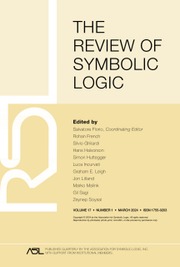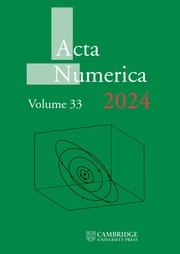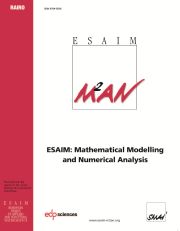Refine search
Actions for selected content:
4291 results in Numerical analysis and computational science
2 - The uniqueness of best approximations
-
- Book:
- Approximation Theory and Methods
- Published online:
- 28 May 2018
- Print publication:
- 31 March 1981, pp 13-21
-
- Chapter
- Export citation
23 - Natural and perfect splines
-
- Book:
- Approximation Theory and Methods
- Published online:
- 28 May 2018
- Print publication:
- 31 March 1981, pp 283-297
-
- Chapter
- Export citation
3 - Approximation operators and some approximating functions
-
- Book:
- Approximation Theory and Methods
- Published online:
- 28 May 2018
- Print publication:
- 31 March 1981, pp 22-32
-
- Chapter
- Export citation
Index
-
- Book:
- Approximation Theory and Methods
- Published online:
- 28 May 2018
- Print publication:
- 31 March 1981, pp 333-339
-
- Chapter
- Export citation
4 - Polynomial interpolation
-
- Book:
- Approximation Theory and Methods
- Published online:
- 28 May 2018
- Print publication:
- 31 March 1981, pp 33-45
-
- Chapter
- Export citation
11 - Least squares approximation
-
- Book:
- Approximation Theory and Methods
- Published online:
- 28 May 2018
- Print publication:
- 31 March 1981, pp 123-135
-
- Chapter
- Export citation

LMS Journal of Computation and Mathematics
-
- Journal
-
- You have access: past subscription

The Review of Symbolic Logic
- Published for: The Association for Symbolic Logic
-
- Journal
-
- Get access
- Contains open access

Acta Numerica
-
- Journal
-
- You have access: full
- Open access
3 - Interpolation
-
- Book:
- A Short Introduction to Numerical Analysis
- Published online:
- 05 February 2015
- Print publication:
- 16 December 1966, pp 14-36
-
- Chapter
- Export citation
Index
-
- Book:
- A Short Introduction to Numerical Analysis
- Published online:
- 05 February 2015
- Print publication:
- 16 December 1966, pp 76-76
-
- Chapter
- Export citation
5 - Numerical Solution of Ordinary Differential Equations
-
- Book:
- A Short Introduction to Numerical Analysis
- Published online:
- 05 February 2015
- Print publication:
- 16 December 1966, pp 52-62
-
- Chapter
- Export citation
Preface
-
-
- Book:
- A Short Introduction to Numerical Analysis
- Published online:
- 05 February 2015
- Print publication:
- 16 December 1966, pp iv-iv
-
- Chapter
- Export citation
2 - Iteration
-
- Book:
- A Short Introduction to Numerical Analysis
- Published online:
- 05 February 2015
- Print publication:
- 16 December 1966, pp 4-13
-
- Chapter
- Export citation
4 - Numerical Integration and Differentiation
-
- Book:
- A Short Introduction to Numerical Analysis
- Published online:
- 05 February 2015
- Print publication:
- 16 December 1966, pp 37-51
-
- Chapter
- Export citation
7 - Solution of Linear Algebraic Equations
-
- Book:
- A Short Introduction to Numerical Analysis
- Published online:
- 05 February 2015
- Print publication:
- 16 December 1966, pp 70-75
-
- Chapter
- Export citation
1 - The role of Numerical Analysis in Science and Engineering
-
- Book:
- A Short Introduction to Numerical Analysis
- Published online:
- 05 February 2015
- Print publication:
- 16 December 1966, pp 1-3
-
- Chapter
- Export citation
6 - Problems Reducible to Simultaneous Equations
-
- Book:
- A Short Introduction to Numerical Analysis
- Published online:
- 05 February 2015
- Print publication:
- 16 December 1966, pp 63-69
-
- Chapter
- Export citation
FURTHER READING
-
- Book:
- A Short Introduction to Numerical Analysis
- Published online:
- 05 February 2015
- Print publication:
- 16 December 1966, pp 76-76
-
- Chapter
- Export citation

